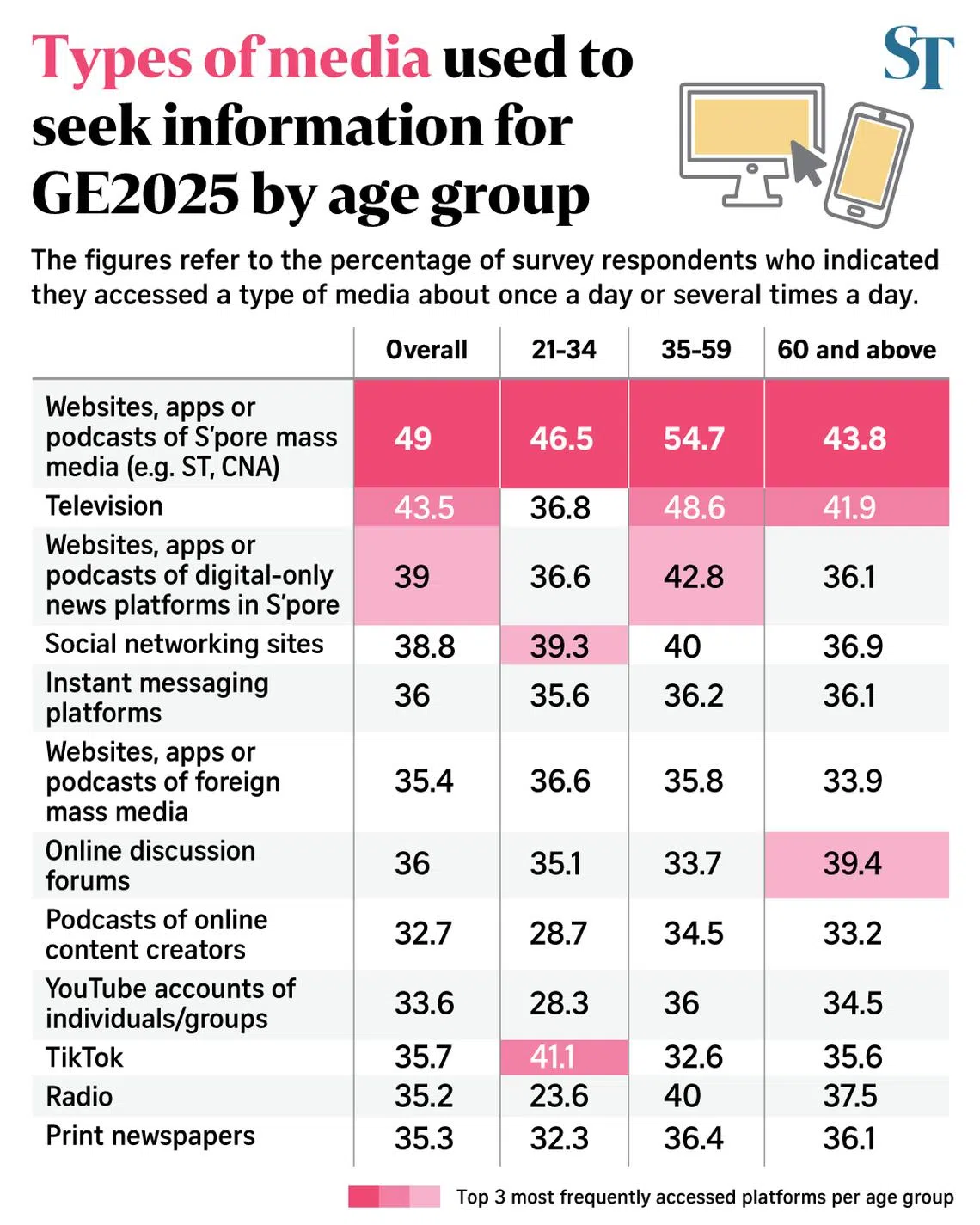S’poreans mostly relied on digital platforms of traditional media for GE2025 information
Sign up now: Get ST's newsletters delivered to your inbox

Digital platforms of outlets like The Straits Times were most frequently used by both younger and older people who previously relied on other sources.
ST PHOTO: GIN TAY
Follow topic:
- Survey shows voters in the 2025 election primarily used traditional media's websites, apps, and podcasts for information, replacing social media and TV.
- Digital platforms of legacy media were accessed by 49% of respondents daily, with television at 43.5%, and other online outlets at 39%.
- Expressive engagement on social media increased, highlighting the need for parties to tailor content across diverse platforms for better engagement.
AI generated
SINGAPORE – Voters most often turned to websites, apps and podcasts of traditional media for information about the 2025 General Election, a survey has shown.
Digital platforms of news outlets such as The Straits Times, Lianhe Zaobao and CNA were most frequently used by both younger and older people who previously relied on other sources such as social media and television.
This shift in media consumption habits relating to GE2025 came amid greater interest in issues connected to the contest, which was held on May 3, compared with the previous election.
The online survey, conducted between May 5 and 20 by the Institute of Policy Studies and the National University of Singapore’s communications and new media department, polled 2,071 respondents.
Results of the survey were released on Sept 2.
It found that local “legacy media” – traditional mass media which existed before the digital age – benefited from digital transformation and innovation and caught up with non-legacy media by adopting a wide range of formats to reach out to audiences and voters.
The legacy media outlets’ digital platforms, such as apps and podcasts, were accessed by 49 per cent of respondents about once or several times a day, making them the top source of GE2025 information.
Television followed at 43.5 per cent of respondents, while digital platforms such as Rice Media, Mothership and The Online Citizen drew 39 per cent.
During GE2020, younger voters aged 21 to 34 relied mainly on social networking sites, while older voters aged 60 and above preferred TV.
But both groups have since shifted to traditional local media’s digital channels, with TikTok ranking second among the youth.
Explaining the change in preferences among the youth, Dr Carol Soon, the deputy head of NUS’ communications and new media department, said that seeking election-related information could be different from regular information-seeking behaviour.
Speaking at a media briefing on Sept 1 about the survey results, she said: “One way that we could interpret this is that during election time, people – even the youth – want accurate, timely information, and that’s one place where they feel they can get that.”
Rising concerns about online harms, misinformation and disinformation were another reason, Dr Soon added.
In GE2025, the PAP won 87 out of 97 seats
The survey found that about 74 per cent of voters were very or extremely interested in issues relating to the election, up from 66 per cent in an earlier iteration of the same poll done after GE2020.
Opposition voters were more engaged with the election across different media platforms than PAP voters, the 2025 survey showed.
Both PAP and opposition voters used legacy media more frequently than non-legacy media, which includes podcasts of online content creators and online discussion forums such as Reddit and HardwareZone.
The survey also measured the extent of social media engagement by the voters, and found the sharpest rise in their “expressive engagement” compared with GE2020. This includes commenting on a page, post or video about a candidate or a political party, or participating in an online discussion.
Associate Professor Natalie Pang, head of NUS’ communications and new media department, said this means that candidates and political parties need to understand the various platforms and their audiences, and create content that is best suited for these channels for better engagement.
“For a party, they cannot go into an election thinking there’s a one-size-fits-all,” she said.
The survey found that voters use social media more than traditional party channels, such as TV and radio broadcasts, candidates’ websites or brochures and newsletters, to get to know political parties and candidates.

With several PAP and opposition candidates appearing across various podcasts in the lead-up to GE2025
However, the survey found that fewer people used podcasts than TikTok and social networking sites.
Said Prof Pang: “The answer is not that straightforward. It really depends on what the podcasts are used for. Is it for expressing opinion? Is it for getting information or is it to connect?... We do see for some voters, especially for the older voters, podcasts are more important.”


